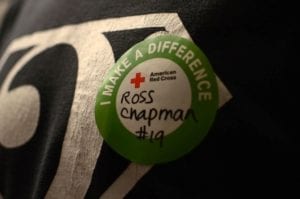Meguna Nakai
Nagoya, Japan

A person who contributed to the Red Cross. Creative Commons.
In 2020 Japan will host the second Tokyo Olympics. When the first Olympics were televised in 1964, people were surprised to find that Japan had developed so quickly even though only nineteen years had passed after World War II. Yet there remained much to be done.
One urgent need was to improve the system of blood services.1 This required making people understand that “yellow blood” from paid blood donations could cause serious diseases.
The beginning of Japanese blood services was during World War II.2 Already in 1919 the surgeon Hiroshige Shiota had carried out a successful blood transfusion, thus saving the life of a twenty-nine-year woman who had a huge uterine fibroid.3 Then, in 1930, an emergency occurred when prime minister Osachi Hamaguchi was shot in the abdomen and a blood transfusion was conducted urgently and successfully.2, 3 Such transfusions were primitive in that doctors used blood from donors without even examining them and injecting the blood directly into the patient.4 After that event the distribution of yellow blood became a societal issue as people constantly selling their blood for money could not regenerate their red cells quickly, leaving only yellow plasma in the donated blood.5 Some people would sell their blood seventy times a month.6 Because of the lack of control many Japanese people were infected with serious diseases.7 Yet that did not stop the donation of blood because it was a thriving business.2 Even after public and private blood banks were established in 1951, voluntary blood donations decreased sharply because private blood banks were monopolizing donors for blood collections.2
Public opinion began to change in 1962, when people began to campaign to abolish paid blood donations.2 Japanese high-school and university students rose up against paid blood donations, forcing the National Diet to address the issue. The turning point spurring the improvement of Japanese blood services was the emergency when Edwin Reischauer, the American ambassador, was shot and received a transfusion that infected him with serum hepatitis.8 This incident proved to Japanese citizens just how dangerous paid blood donation was, but improvements were made gradually.
In 1951 the Japanese Cabinet announced it would restrict paid blood donations and establish a secure system of blood donations.2 This change was not well received by the people selling their blood and making a business out of it.2 In 1969 Japan halted the distribution of blood products made by private blood collection banks.2 Commercial blood banks were then set up where individuals and their family could draw back the blood they had deposited when healthy.2 In 1972, all blood banks were closed and all voluntary blood donations were achieved.2 Thus, the basic system of blood donation in Japan was established after overcoming many difficulties.
Yet Japan and other countries still face some problems in procuring blood for transfusion. One problem stems from the fact some European countries, the United States, and China are still allowing blood banks and paid donations.9 Also, aging societies are in need of more blood. In Japan, 85% of patients requiring transfusions are over fifty years old, whereas 76% of donors are younger. In time there will be more patients in need of blood transfusions and fewer donors supplying blood.10 This is also to some extent happening in other countries. Furthermore, many of the women willing to donate blood are themselves anemic.11 Yet at present the best way to improve blood services is simply to donate one’s own blood. Blood transfusion is an urgent lifeline for patients.
References
- Inoue, N. Tokyo Olympics. https://www.osaka.med.or.jp/img/doctor/bulletin01-img3.pdf Published 2018. Accessed December 11, 2019.
- Blood services. Japanese Red Cross Society. https://www.jrc.or.jp/english/pdf/Blood_Services_2014.pdf. Updated 2014 Accessed November 23, 2019.
- Hamaguchi shuso sogeki de yuketsu shirewataru [Blood transfusion was noticed by the emergency the prime minister, Hamaguchi was shot]. Akita medical association. https://www.akiyaku.or.jp/hyakuyaku/hyakuyaku.html?pmid=274 Updated 1996. Accessed December 2, 2019.
- Japanese Red Cross Society. Nihon ni okeru kenketsu niyoru ketsuekijigyo no hatten [Improvement of blood services in Japan]. Japanese journal of transfusion medicine. 1993; 39(1):151-157.
- Yellow blood. Japanese Red Cross Society. https://www.bs.jrc.or.jp/ktks/tokyo/special/m6_02_02_07_02_detail64.html Accessed December 11, 2019.
- Ketsueki jigyo no rekishi [History of blood service]. Osaka Red Cross Center. https://www.bs.jrc.or.jp/kk/osaka/special/m6_01_history.html Accessed December 2, 2019.
- Supreme Court precedent. Supreme Court. https://www.courts.go.jp/app/hanrei_jp/detail2?id=54824 Accessed December 11, 2019.
- Yuketsugo kan-entaisaku no kikkake ni natta raisyawa jiken [An emergency of Reischauer developed Japanese transfusion system]. The Asahi Shimbun. https://www.asahi.com/articles/ASKCJ6QJMKCJUBQU02L.html Updated November 17, 2017. Accessed December 11, 2019.
- World Health Organization & International Federation of Red Cross and Red Crescent Societies. Towards 100% voluntary blood donation: A global framework for action. World Health Organization. 2010: 1-123.
- Doshite ketsueki ga husoku suruno? [Why is blood short]. Japanese Red Cross Society. https://www.bs.jrc.or.jp/tkhr/bbc/special/m6_03_05_20160202-5.html Accessed December 11, 2019.
- Matsusaka, M. Wagakuni no kenketsu no genjo to kadai [The situation of Japanese blood services and problems] Japanese journal of transfusion and cell therapy. 2013; 59(5): 725-732.
MEGUNA NAKAI is a third-year student at Sugiyama Jogakuen University in Nagoya, in central Japan. She is interested in World Englishes, sociolinguistics, and second language acquisition through applied linguistics. She works at an English cram school teaching English to Japanese children. She is also working on obtaining certification to work at a childcare facility.
Submitted for the 2019–2020 Blood Writing Contest

Leave a Reply